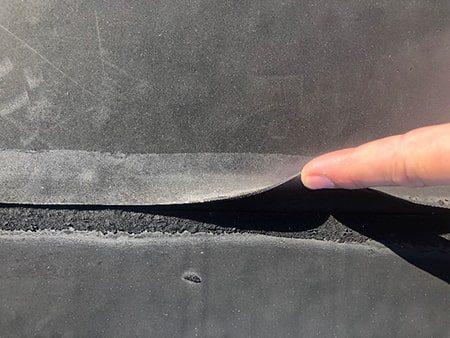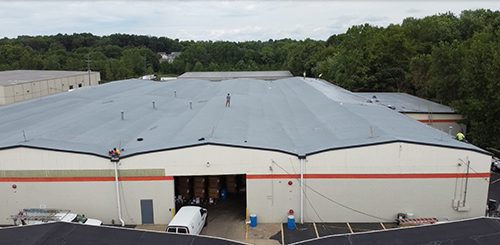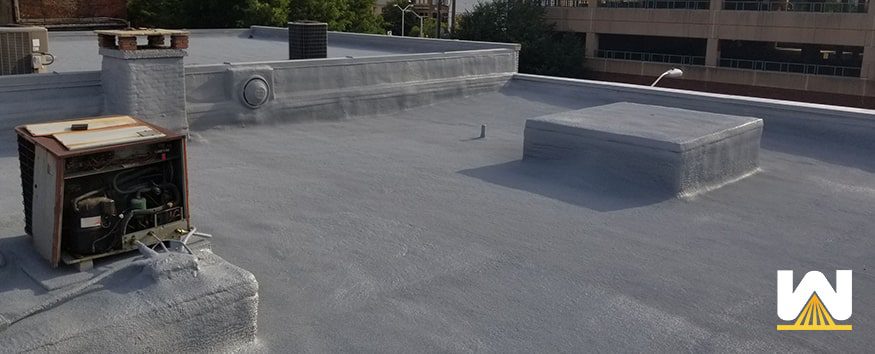So, perhaps you’ve heard the term “Monolithic” or “Seamless” roofing systems?
You may be thinking, “Who cares if it’s monolithic, as long as the roof doesn’t leak, that’s all that matters.”
You’re right! We all want a roof that does exactly what it’s supposed to do…not leak.
In this article, you’ll learn:
- What is a monolithic roof system? (and what are some examples)
- Why should a building owner care about monolithic roof systems?
- Two popular monolithic roof systems: spray foam and silicone roof coatings
We wanted to let you know that we write articles based on true events and experiences. Every piece of content written at West Roofing Systems is produced in-house. Every article is reviewed and edited by a roofer/salesman with more than 30+ years of experience in the field.
Let’s get started!
What is a monolithic roofing system?
A monolithic roofing system is a roof system where the membrane is one layer. Examples would be silicone roof coating systems or spray-on roofing systems.
A non-monolithic roofing system is a roof system where the membrane isn’t one layer. An example would be any roofing system where multiple sections are fastened together. These would include metal roofing systems, Built-up roofs, TPO, EPDM, and PVC, which all have mutable seams.
Why should a building owner care about monolithic roof systems?
A roof with seams has a higher likelihood of leaking than a monolithic roof.
Non-monolithic roofing systems use seams, fasteners, and adhesives to “piece” roofing sections together.
These “pieces” are what commonly fail that end up producing leaks inside your facility.
How do seams fail on a roofing system:

-
- TPO seams are commonly fused with a heat gun. If the heat gun is too hot during installation, it will burn the TPO and produce pinholes. If the heat gun isn’t hot enough, the seams may appear attached, when they might not be 100%.
-
- UV rays can degrade the adhesives that keep sheets of roofing materials attached.
- If a roof is mechanically fastened (using screws and plates), screws can back out and damage the membrane.
If a seam fails, water has easy access to the roof insulation below. When enough water saturates the insulation, there’s no other way for the water to go besides in your roof deck and into your building.
When enough of the roof’s insulation is saturated (about 25%) that’s the usual amount of wet insulation roofing contractors take to decide if the best repair option is to restore the roof or completely tear it off.
More than 25% saturation = 100% tear off.
Less than 25% saturation = remove only the saturated areas and restore the remaining roof.
A complete roof tear-off can cost $6 per square foot and up.
A roof restoration can cost around $2 – $4 per square foot.
Many variables influence the price of a roof repair, such as:
- How much of the roof needs to be torn off and replaced?
- How long of a warranty is the building owner seeking?
- How difficult is the project? (how tall is the building, how many roof transitions, penetrations, and are there different roof systems already installed, etc.)
Is there a way to make your current roof monolithic?
There are two ways to make your current roof monolithic: installing spray polyurethane foam or installing silicone roof coatings.
Spray Polyurethane Foam (SPF) Roofing
Here’s a video of how spray foam is installed over an existing roof:
Spray foam is a great option to repair or rejuvenate an existing roof for many reasons, such as:
- All the tiny holes, cracks, punctures, etc. will be filled and watertight
- No seams
- Closed-cell insulation
- All the flashings and penetration become part of the monolithic roof
- The entire roof is sustainable and renewable
- You’ll likely save money on your energy bills because SPF has an R-value of 6.5 per inch.

Silicone Roof Coatings
Here’s a video of how silicone roof coatings are installed over an existing roof:
Silicone roof coatings are a great option to repair or rejuvenate an existing roof for many reasons, such as:
- All the tiny holes, cracks, punctures, etc. will be filled and watertight
- No seams
- All the flashings and penetration become part of the monolithic roof
- The entire roof is sustainable and renewable
- You’ll likely save money on your energy bills because silicone is white, which reflects the sun, keeping the roof cooler than a darker color.
![]()
What should a building owner do now?
Now that you know what a monolithic roof system is, why they are beneficial to prevent leaking, and some options to get a non-monolithic roof…monolithic, what should you do now?
If your roof isn’t leaking, you may think that you shouldn’t do anything until that happens. This is not a smart decision.
I would contact a roofing contractor immediately.
Why?
Because if your roof is in decent/fair condition, you might be able to restore your roof with a silicone roof coating system.
Silicone roof coating systems usually cost between $2 and $4 per square foot.
If you wait until the roof is leaking, the roof may be in too poor of a condition to restore. You’d then be forced to do a complete tear-off and replacement, which is at a minimum of $6 per square foot.


